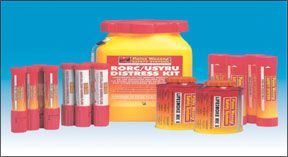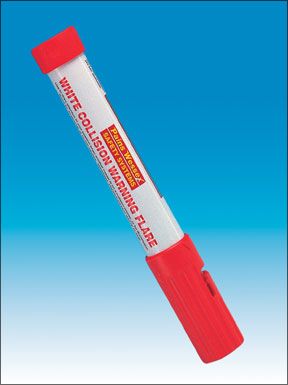White hand flares have been used for signaling since the time of Nelson and Trafalgar. They were used in Civil War times, most famously aboard the ironclad Union ship

288
Classified as hazardous materials, the active ingredients of white hand flares are black powder and magnesium. White hand flares emit NOx, a toxic byproduct. For obvious reasons, instructions are to hold the hand flare downwind. Burning magnesium on flesh, smoke inhalation, or having molten residue blowing down a companionway hatch can lead to dire consequences.
In April 2006, a sailing instructor was severely injured while giving a demonstration of a white hand flare. This resulted in a total recall of white hand flares by their manufacturer, Pains Wessex.
Except to satisfy the Offshore Safety Regulations of the ISAF (International Sailing Federation), the governing body for the sport of sailing, most sailors know little of what a white flare is to be used for. Presumably, white hand flares would be used as a last resort communication for collision avoidance. However,
Practical Sailor is not aware of white hand flares effectively being used to ward off threats of collision. Unlike the sinking Monitor, the last act the crew of a small boat wants to be doing before being run down is attempting to ignite a potentially hazardous and vision-blinding incendiary hand flare in the dark.On a legality note, unlike red flares, white flares are not specifically mentioned in the COLREGS as a signal to attract attention. But a “searchlight aimed in the direction of danger” is prescribed as a signal to attract attention (COLREGS Rule 36). In addition, when two vessels are approaching each other, a light signaling at least five short and rapid flashes indicates doubt whether sufficient action is being taken to avoid collision (COLREGS Rule 34 d).
Arguing that there is little benefit to carrying this potentially explosive product on board and that the need to replace the flares every 3 years is not cost-effective,
Practical Sailor contributor Skip Allan in 2007 mounted a campaign to
288
have white hand flares eliminated as a requirement under the Offshore Special Regs.
Under the guidance of U.S. Sailings Safety at Sea Committee, marine safety expert John Rousmaniere and other committee members drafted wording to remove white hand flares from the ISAF 2008 Offshore Special Regs. Now, the regulations require a high-powered spotlight/searchlight for signalling.
Rechargeable battery-operated, 10-million candle power spotlights are available for less than $100, and the 1-million candle variety cost less than one hand flare-a much more cost-effective alternative to the pricey and perishable four white hand flares that were previously required.
According to Rousmaniere, “The only stumbling block is that there are no widely recognized standards for acceptable lights.” In light of this,
Practical Sailor will re-examine flashlights and spotlights used for emergency purposes. (We last tested rechargeable spotlights in the March 2005 issue and flashlights in the December 2007 issue.) If you have products youd like to recommend, e-mail them topracticalsailor@belvoirpubs.com.
To dispose of any expired or unwanted white hand flares, contact your local U.S. Coast Guard, police agency, or fire department for advice on proper disposal in your area.

































